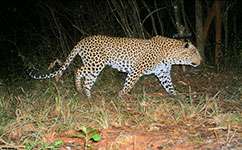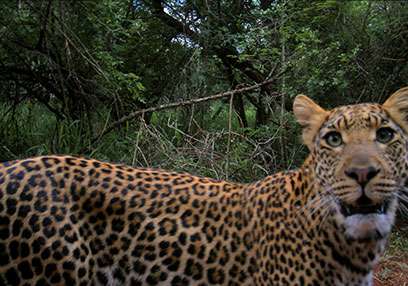Leopards persist in mountain range despite persecution

An inaccessible, rugged mountain region in northeast South Africa is home to the densest leopard population outside a state-protected area anywhere in Africa, according to a recent study.
Despite this, scientists say until these findings are confirmed, calls to increase trophy hunting permits should be resisted to make sure the leopard population is viable and self-sustaining.
'Trophy hunters are currently calling for more permits to hunt leopard in this area, but luckily, the South African government doesn't have the data to allow this at the moment,' says Dr Julia Chase Grey, a research fellow at Durham University and lead author of the study, published in PLoS ONE.
There's a lack of widespread scientific input in quota setting for legal trophy hunting in many countries, and few data exist on leopard numbers in many areas in which they're hunted.
In an effort to remedy this, Chase Grey used a network of camera traps to estimate leopard numbers over an 84km2 region of the Soutpansberg Mountains in South Africa.
The researchers found that the area supports on average nearly 11 leopards per 100km2. This compares with just one to three over the same area in the Cederberg and Waterberg Mountains, also in South Africa.
Only state-protected national parks, such as the Kruger National Park and Gabon's Ivindo National Park support a greater density of leopards: the Sabie river area of the southern Kruger supports just over 30 of the animals per 100 km2, while the Ivindo supports 12.
'Our results suggest a significant leopard population within the Soutpansberg Mountains,' says Chase Grey.

The western Soutpansberg in northeast South Africa is part of the Vhembe Biosphere Reserve, and is recognised as a hotspot of biodiversity.
The region supported elephants and black rhinos until hunters wiped them out and cattle farmers made their habitat more suitable for agriculture. Now, the only large carnivores that still exist in the mountain range are leopards, and brown and spotted hyaena.
Chase Grey and her colleagues suspect the leopards have remained in the Soutpansberg Mountains despite hunting and persecution from local farmers in the lower levels of the mountain range..
Together with loss of habitat, these threats have led to a worldwide drop in leopard numbers over the last 100 years. In Africa alone, leopards have disappeared entirely from over a third of their historical range. Some of the most dramatic range loss has occurred in South Africa.
The situation is so grave that the International Union for Conservation of Nature (IUCN) changed the leopard's conservation status from Least Concern in 2002 to Near Threatened in 2008.
The researchers think one of the reasons the leopards have successfully made the Soutpansberg Mountains their home is because it supports one of their favourite prey, the bushbuck. Not just that, but the mountains are mostly inaccessible to farmers, which means the leopards are less likely to be targeted.
Chase Grey is keen to point out the limitations of the study: 'Our study only represents a point density estimate, and longer-term camera trapping surveys need to be undertaken in order to examine population fluctuations and the effects of factors such as seasonality on leopard population numbers.'
'We now need long-term data on leopard densities over a larger area in the western Soutpansberg to confirm the conservation importance of the area,' she adds.
If the results are confirmed and the population persists, the area could one day become a recognised conservation area.
More information: Julia N. Chase Grey, Vivien T. Kent, Russell A. Hill, Evidence of a high density population of harvested leopards in a montane environment, PLoS ONE 8(12): e82832, published 9 December 2013, DOI: 10.1371/journal.pone.0082832
Journal information: PLoS ONE
Provided by PlanetEarth Online
This story is republished courtesy of Planet Earth online, a free, companion website to the award-winning magazine Planet Earth published and funded by the Natural Environment Research Council (NERC).





















